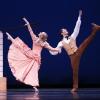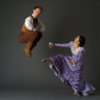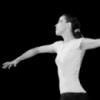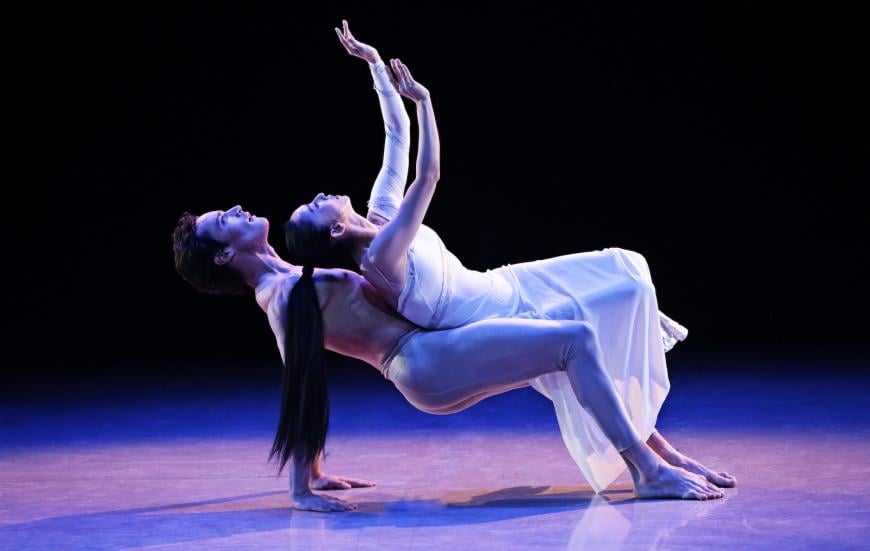
With the world in yet more chaos — the lingering pandemic and Russia’s war on Ukraine — we often turn to artists for solace. Indeed, such comfort can certainly be found in many of the works of Martha Graham, the heralded mother of modern dance, who founded her namesake troupe — Martha Graham Dance Company — in 1926. For Janet Eilber, former Graham dancer and the ensemble’s artistic director since 2005, many of Graham’s legendary dances remain relevant, resonant, and a ready source of joy.
And on March 19, audiences will have a chance to get their art fix, when MGDC takes to the stage of The Soraya in a bill of three works: a world premiere, The New Canticle for Innocent Comedians; and two Graham classics, Lamentation and Chronicle. The premiere features original music commissioned by The Soraya, composed and performed live by jazz pianist Jason Moran, while the solo, Lamentation, is danced by Natasha M. Diamond-Walker to Zoltán Kodály’s original piano score, and Chronicle is a work for 12 dancers with Wallingford Riegger’s music also performed live by Wild Up, led by the group’s musical director Christopher Rountree.
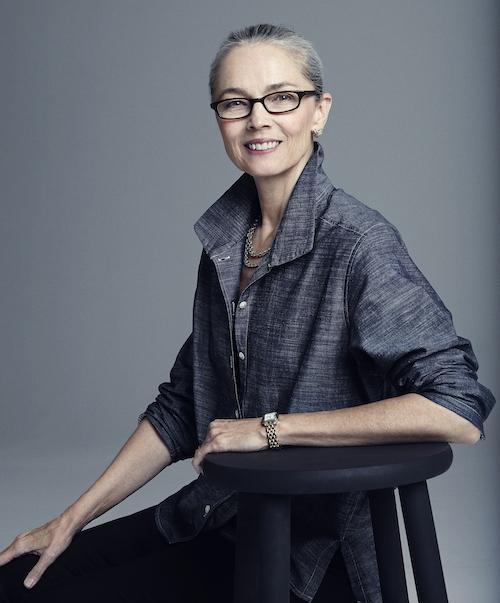
“The genesis of the concert,” explained Eilber, speaking from Santa Fe, New Mexico, one of the cities on the company’s two-month tour, “is that we do themes each season, and we wanted to do a theme that would allow us to feature Martha’s reverence for the human body — and also her use of nature as a metaphor in so many of her works — Appalachian Spring, Dark Meadow. So, we decided on a theme of human/nature, to bring those aspects of Martha’s works forward.
“One of the major works in Martha’s past,” continued Eilber, “was Canticle. She premiered it in 1952, but it was never filmed, except for [the vignette] ‘Moon,’ which was filmed for the documentary, A Dancer’s World. We researched Canticle, thinking that maybe we can bring it back to the stage, but I didn’t think we could do an authentic job. At the same time, we’re building our name as a commissioner of new works and I was looking for a way to work with the up-and-coming generation.”
The original Canticle for Innocent Comedians (the somewhat odd-sounding title comes from a poem of the same name by Ben Belitt), comprises eight virtuosic vignettes, each celebrating a different aspect of nature — Sun, Earth, Wind, Water, Fire, Moon, Stars, and Death. Reimagined by Eilber, who commissioned nine choreographers from diverse dance backgrounds, the work, with its new Moran score, promises to be as evocative as Graham herself.
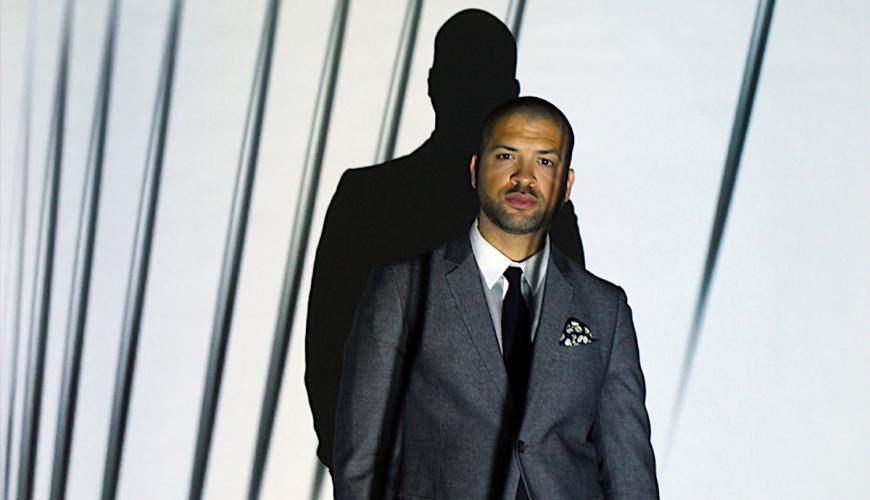
“This idea took hold about four years ago,” Eilber recalled. “We needed a cohesive factor to it, one lead choreographer for the opening and closing and interludes, so we chose [Emmy and Tony Award winner] Sonya Tayeh. At the time, we were also talking about having a different composer for each vignette, but we jettisoned that and decided to commission one composer, Jason Moran. [Executive and Artistic Director of The Soraya] Thor Steingraber recommended him.
“We know what Thomas Ribbink’s original score was, but it had a checkered past,” added Eilber. “Martha had an argument with him and sometimes didn’t use it. We decided, since we were creating a brand-new work, except for “Moon,” we wanted to contemporize everything — the movement and the score.”
In addition to Tayeh, Eilber chose emerging choreographers Kristina and Sadé Alleyne (sisters), Juliano Nuñes, Micaela Taylor, Yin Yue, and Jenn Freeman, who created the vignettes, “Earth,” “Water,” “Fire,” “Stars,” and “Death.” Eilber also commissioned Sir Robert Cohan, who danced in the original 1952 cast and who created a new “Wind” for Canticle in 2020, just before he passed away at age 95 in January of last year.
“Bob went on to bring modern dance to the United Kingdom, and the Graham style. He opened a school, had his own company and was a major factor in the dance world in the UK. I turned to him in the fall of 2019 and asked, ‘How do you feel about creating a new “Wind” for one of our dancers?’ and he said, ‘I’ll do it.’ Laurel Dalley Smith is from the U.K. and Bob created this beautiful solo for her and we feel lucky to have this.”
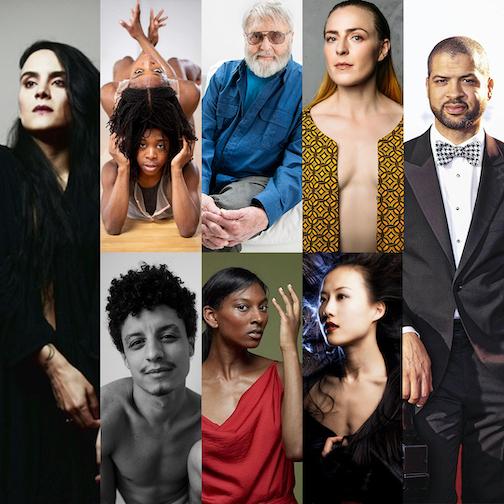
Instead of making the dance to a temp track — an existing piece of music — Cohan opted to create the solo to silence. “The accompaniment is the breath of the dancer and her movement,” noted Eilber, “and in the course of putting together the whole thing, we decided to leave that section in silence. In a 40-minute work, you want some variation, some moments that bring the audience a new way of looking at what’s on stage.”
As for the relationship between New York-based MGDC and The Soraya, it’s been ongoing for nearly a decade and includes pairing Eilber with Wild Up and Rountree in 2016. In 2020, at the height of the pandemic, The Soraya commissioned a new film version of Graham’s solo Immediate Tragedy, a piece she created in 1937 in response to the Spanish Civil War.
“Thor is so sympatico,” Eilber said. “From our first time out there, I think it was as early as 2013, we had these long conversations. We spoke each other’s language about a creative approach to curating classics, which is what he does — and surrounding them with new work. It’s what we do all over the world, too. A lot of presenters think that classics are in one category, new works in another. When they’re well-curated, it’s elevating and there’s so much context and resonance between the two.”
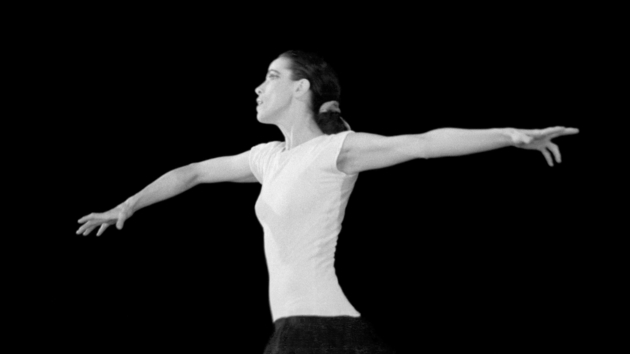
In a press release, Steingraber said, “The Soraya has long been a leader in multidisciplinary work, a matchmaker between artforms and artists, and a proud commissioner of new works. Over several years and numerous projects, we’ve forged a rich relationship with Martha Graham Dance Company and its esteemed artistic director, Janet Eilber, and have contributed to the company’s historic involvement with contemporary music, one that dates back to Martha Graham’s commissions with great composers like Aaron Copland, and now continues with Christopher Rountree and Wild Up, and Jason Moran.”
Following the premiere, the three organizations will collaborate to record the score of Canticle beginning a multi-year project to record compositions for which recordings are lost or are poor quality. By doing so, several Graham pieces will be reinvigorated to tour again to venues where live music is not possible.
Lamentation (1930) and Chronicle (1936) round out the bill and are both considered timeless as well as cathartic. In the former, the dance is performed almost entirely from a seated position, with the dancer encased in a tube of purple jersey. Radical then and still radical now, the work creates tensions formed by the dancer’s body that’s struggling within the material. In the process, the performer creates a moving sculpture, a visual portrait that is the very essence of grief.
With Chronicle, Graham created a dance in response to the menace of fascism in Europe. In early 1936, she had refused an invitation to take part in that year’s Olympic Games in Germany, stating, “I would find it impossible to dance in Germany at the present time. So many artists whom I respect and admire have been persecuted, have been deprived of the right to work for ridiculous and unsatisfactory reasons, that I should consider it impossible to identify myself, by accepting the invitation, with the regime that has made such things possible.”
One of the few dances Graham created that can be said to explicitly express political ideas, the intent of Chronicle was to universalize the tragedy of war. Stated Eilber: “With what’s going on in the world today, you just feel how these works resonate in any era, in changing atmospheres. We’re dancing them as we came back from the pandemic. They resonated with the pandemic, and now with Ukraine. You feel them on your skin.”
What’s also felt is the pressure of unveiling an ambitious world premiere and the concept of opening night butterflies. One wonders if Graham, herself, felt nervous and, in turn, if Eilber does. Laughingly, the director replied. “Oh, yes, I once saw her throw up. Martha was very sensitive to putting her creations out there. Am I nervous? Yes. I was more nervous a month ago, but seeing pieces of it come together in the last few weeks — we had an open rehearsal last week — the audience was gobsmacked, floored, they were so impressed and enthusiastic, I’m thinking we’ll do just fine.”
Carrying on the Graham legacy, while no easy task, is, according to Eilber, “a labor of love. I’m tired sometimes, and it’s a lot of work, but as a curator, to have the type of material I’m curating — one of the greatest dance legacies that exists and one of the geniuses of modernism, bar none — I can’t complain about that. What Martha has left behind, we can just dive into the depth and breadth of her legacy and it will inspire innumerable new projects every day — as much as the traffic will bear.”
And that traffic will be plentiful, especially as Martha Graham Dance Company prepares for its 100th anniversary. “The actual date is April 18, 2026,” Eilber enthused, “and again, curating this stuff is incredibly exciting. It’s really going to be about narrowing it down. We’re putting out as many feelers and ideas as we can and it’s like a listening tour. At a certain point, we’re going to have to decide what to prioritize, but we’ll start celebrating the year before and the year after — and maybe longer.”


